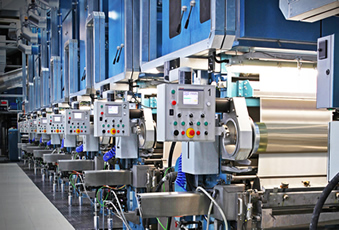In general, the formula for making foamed PVC sheets is almost the same. And in terms of quality, there is a special classification in this industry, which is 4 levels. Premium grade, first grade, one and a half grade, second grade
This rating definitely affects the prices. Because the quality characteristics of each are different
Some of these characteristics include the tolerance of dimensions and thickness of the sheets, the number of bubbles in the central part of the sheet, the change in the color of the PVC sheets, which of course, this change is like the formulation of the sheets is manipulated. These characteristics can increase or decrease the quality
Having a smooth and polished surface of foamed PVC sheets
The smooth and even surface of the foamed PVC sheets without roughness, dents and protrusions can be easily seen by the eye and can be recognized by dragging the hand on the surface of the sheet. The smoothness makes the foamed sheets look beautiful and even makes the polishing, sanding and puttying time of the sheet to make the final product less and saves time. According to these features and explanations, it is clear that the smoother and more polished the surface of foamed PVC sheets is, the higher the quality.
The degree of hardness of the surface of foamed sheets
In foamed PVC sheets, the higher the hardness of the surface, the higher the quality, because the higher the surface of the foamed sheets, the higher the level of colorability, and also they have less cracking, breaking and bending when cutting, and also keep the pages well. they have
To determine the surface hardness of foamed sheets, factories use special devices for measuring the surface hardness, but in the market, for those who want to prepare PVC foamed sheets and do not have access to this device, they can do so without special tools, only with Put your nail on the surface of the sheet to press, and if the nail mark remains and causes bends and scratches, it is clear that it is not of good quality.
The sheet is not bubbled
The more bubbles and holes in the foamed sheets, the poorer the quality of the sheet. These bubbles make PVC foamed sheets unusually light, and they also cannot hold the page, and when cutting, it is difficult to produce waste. They cut a lot. The reason for the existence of these bubbles is that in the process of making and producing these sheets, it happens when cooling inside or outside the mold. When the surface cools, the central part is still hot and shrinks as it cools, causing Bubbles are formed.
The amount of twisting of foamed PVC sheets
One of the characteristics of foamed PVC sheets is the ability to fold pages. And the higher the number of pages, the higher the quality of the product. Foamed PVC sheets have a relatively high density and density, which makes them resistant to twisting, which means the shelf life depends on the quality of these sheets. According to the points raised, the question arises, how to perform the screwing test? The answer to the question is that you can use a special page to page several different parts of the sheet and try to remove the screws vertically from the sheet. If it comes out easily and there is a hole larger than the size of the same page in the sheet, it shows that the sheet is of poor quality. The harder the screws are to remove, the higher the quality of the foamed sheet
Lack of stamina and lack of bending
Bending and having any degree of curvature, whether it is high or slight, has an effect on the quality of the product. For this purpose, there is a phenomenon called creep, which determines what effect it will have and what kind of change it will cause if industrial foamed sheets or polymer parts are subjected to a constant force for a long time. Of course, warping and bending of the surface of foamed sheets may occur in the production process during cooling, which affects the quality of the product. In order to detect the absence of warping and bending, you can carefully look at its surface with your eyes, or use a caliper, or use a dial and digital devil’s watch.


